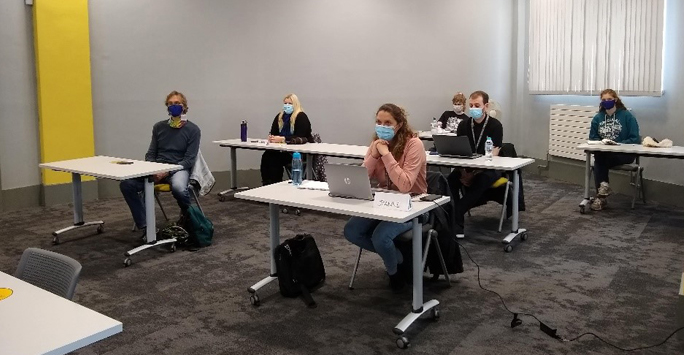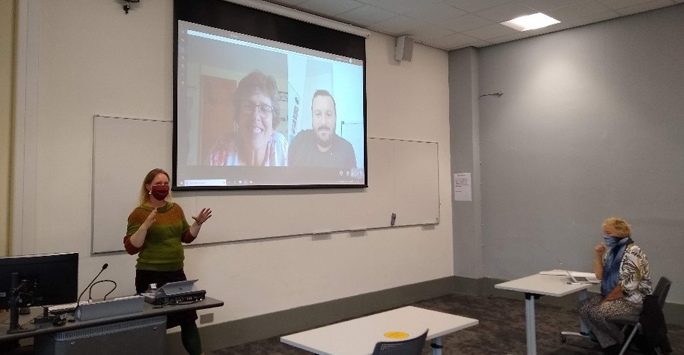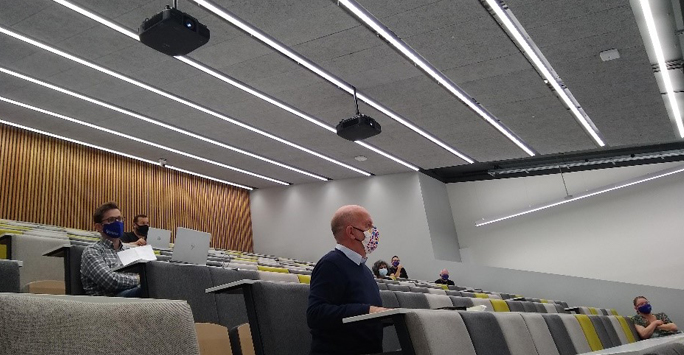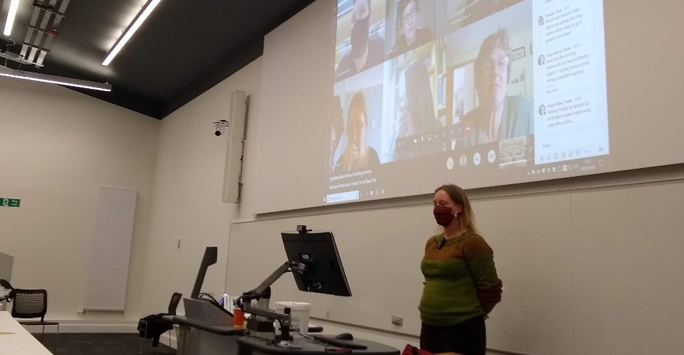Trying out Hybrid Teaching on Campus
Posted on: 29 September 2020 by Prof Kristyan Spelman Miller in General

Colleagues joined a trial of on-campus teaching to gain first-hand experience of teaching in a socially distanced way, with some participating as remote learners. Please read on to find out our observations with the trial.
On 24th and 25th September, as part of our planning for this year’s hybrid learning and teaching, a number of colleagues from the Faculty joined Tunde Varga-Akins (CIE), Eli Saetnan (Academy) and officers from the Guild to try out on-campus teaching. The aim of the try-out was for us to gain first-hand experience of being back on campus in classrooms, testing out the practicalities from arrival to departure, and participating in teaching activities in a socially distanced setting (with Health and Safety arrangements in place).
Two mock small group sessions were held, led by Tunde and Eli, with participants acting as students in two settings: one session in a tiered lecture room in 502 and one in a flat seminar room in 126 Mount Pleasant. A number of us also participated in the sessions as remote learners, to test joining and participating in the live session via Teams. The team made a number of observations which are summarised briefly below, with some photos from the two sessions.

Firstly, in terms of the face-to-face classroom experience, the overriding impression was that it was good to be back in the classroom although the experience was clearly different. Some key observations were:
- with fixed seating and no mobility within the rooms, conducting group and pairwork required talking across space. In the tiered room, turning around to talk was not comfortable for everyone.
- Students wearing face-masks were audible to each other and to the staff member leading the session.
- Sound quality was enhanced when wearing a visor, although wearing these for longer than an hour may be uncomfortable.
- Opportunity for informal conversation (such as through ice breakers) was an important aspect of building confidence and connectedness within the group.
- Interacting across the class worked well. Given that students were wearing masks, participants resorted to lots of non-verbal cues, such as hand-signals to help with turn-taking, expressing reactions, and so on.
- Whole class discussion worked well when participants were reminded to speak up one at a time. Those in the room could hear everyone, even those at the back of the room, although the layout of the room made a difference (audibility greater in the tiered room).
- Pairwork worked best, or when groups of three sat nearer to each other. With larger groups, noise levels interfered with understanding.
- Seating arrangements of the groups made a difference; if possible it is better to avoid different group members being in the cross-line of another group.

(Tiered room in 502)

In general participants felt safe with social distancing measures in place. They were pleasantly surprised that the dynamics of the classroom were still possible and commented that they enjoyed the human interaction and conversation. There were some practical issues with arrival (signage and navigation) and ensuring students were seated appropriately. Some other points were noted about responsibilities and arrangements for cleaning. It was also felt that the set-up in the room took longer; however, this gave an opportunity for informal conversation before the session began.
Another aspect of our try-out was to investigate the experience of remote students joining a live class on-campus. For this, a number of ‘students’ joined the session via Teams. Some observations from this were:
- It was straightforward for the remote participants to join the group with this technology and it was possible for the participants to see the class through the camera and contribute via the chat function.
- Connecting to Teams worked well for both remote and in-class participants and on mobiles as well as laptops. Sound on student devices needed muting to avoid feedback. There was also some concern that students may not want to appear projected on the large screen, so would prefer not to use their camera.
- In order to feel part of the group there needed to be considerable and continuous effort on the part of the teacher in the room to involve the remote learners.
- Having the remote students appear on screen and chat was potentially distracting for those in the room.
- The remote participants could hear the teacher at the front well but, depending on the room layout, not all the students in the room.
- Remote participants could not see individual students in the room (unless their camera was also switched on via Teams) and so would need introductions.
- Live captions via Teams was possible, though distracting for some.
- The use of breakout rooms for pair and groupwork worked well for the remote students as they felt integrated in the whole class.
- When the session involved more in-class discussion (rather than pair and group work) the remote participants felt more disconnected. Effort was needed to bring them back into the activity in the room.
- It was helpful when a scribe in the classroom added commentary of clarification in the chat to confirm what was being discussed (where sound quality was difficult).
- There were some concerns about sufficient charging points in rooms and potential wifi issues for a class using technology to interact with remote students.
- Remote participants had to concentrate very hard to stay engaged.
This invaluable try-out experience has led to some conclusions and recommendations which are being taken forward in CIE guidance.
Firstly, the in-class experience of the trial was very positive. Participants felt good about the dynamics in the class and enjoyed the opportunity to interact with purpose. Designing a rich active learning experience in the classroom must be our key objective.
Secondly, the inclusion of the remote learners in an on-campus session brought its own difficulties, although it did provide an opportunity for remote students to connect with the Liverpool campus and the larger cohort. The technology did make remoting in possible; however, juggling the demands of both on-campus and remote learners would be challenging for the staff leading the session to manage both groups and the technology successfully.
For remote learners unable to come to campus for the face-to-face session, it is important that steps are taken to ensure these students have access to the learning they would otherwise have had through the on-campus session.
The optimal arrangement would be for a dedicated on-line webinar to be scheduled for these remote students which would cover the same content and run the same or equivalent activities on-line.
If this was not practical or viable (for example, given small student numbers), remote learners should have access to the materials used in the on-campus session. Where possible and appropriate, parts of the on-campus session could be recorded and made available via the VLE. Notes or summary points from the session would also be a useful resource for the remote students. Finally, there should be opportunities for those students to check their understanding and learning with the lecturer, for example through office hours.
It is still possible that some staff may wish to involve and integrate remote students in live sessions through the use of technology. Given the different configurations of rooms, it would be necessary for the lecturer to check the room and sound in advance of teaching.
In conclusion, as we embark on teaching in this new environment, we will need to try out new solutions and adjust as we go. Keeping teaching arrangements simple at the outset is sensible, leaving us room to develop our approaches as we learn. The important thing is to focus on what makes a teaching session a good active learning experience. Small groups learning and teaching can be extremely rewarding and enjoyable. We look forward to following the experiences of all during the semester.
Keywords: Hybrid Learning, Active Learning, Small Group Teaching, Social Distancing, On Campus Students, Remote Students.